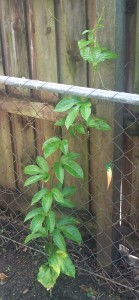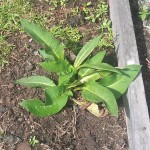Backyard Gardening Thoughts and Ideas
1st April 2013
Have been in this home since late February this year. It is about time I started this blog. Though publishing it may take me a while.
Luckily I am not relying on making a living from the net. I guess that is a blessing and a curse. By not having any pressure to achieve results I can stuff about with a number of different projects and keep dreaming about making my fortune. At the same time I have to admit that I am enjoying myself immensely.
I am starting a garden, getting my worm farm back into production and trying to find the right things to grow here in Queensland in a semi-tropical environment. I also want to create a blog about what I learn and pass it on. One of the tasks in life is to commit to something and having once committed keep at it through the ups and downs.
One of my aims (dreams) is to be independent and self sufficient but still in an urban environment.
I know that to do the things I want to do I will have to learn to concentrate better and have a timetable. Maybe writing a blog will help with these things.
Since being here I have planted a couple of passion fruit vines. I went to the Caboolture Market one Sunday morning and they were a bargain at $2.00 each. I also bought some Comfrey plants, which were also a bargain at around $1.50 each. The comfrey is for the compost heap. It has very deep roots and brings up the minerals into the leaves. I can remember an old horse guy who used to feed it to his horses and drink it as a tea. He swore by it as a mineral supplement.
Another reason for the Comfrey is that it is supposed to choke out weeds and even suppresses runner grass like couch and kikuyu. Eventually I would like to remove all the couch and other grasses and create a comfrey barrier around the fenceline. To remove the couch in the middle of the yard I have laid out some builder’s black plastic and will set up my worm farm on it. After 12 months I will move the worms and the couch should be killed underneath. I will then use the area for my next garden.
I have also been doing a bit of digging to create a vegetable garden. Yesterday I threw some Mung Bean seeds on the patch I had dug and gave it a rake over. It rained overnight and when I looked this morning some seeds had sprouted and others had swelled up ready to sprout. The rain had washed off any soil cover the light raking had given them. I covered the seeds with grass from the compost pile I had started. The block is 1000sqm (1/4 acre) so I collect quite a few lawn clippings and decided that a good compost heap would be great to create food for the worms and also as a tonic for the garden.
The grass clippings had heated up considerably but hadn’t turned into compost as it has only been there for six weeks. The grass has been mown 4 times and the pile is starting to grow. I raked about in it and found some dark looking clippings that had heated up and used this to cover the Mung Bean seeds.
The Mung Bean is just an experiment. I purchased the packet six months ago to have a go at sprouts. They sprouted well. Whether they will grow is another story. I am doing it as a green manure. I am interested to seel if they will grow. From what I have read I should use an innoculant of Rhizobium to coat the seeds with. The innoculant is a bacteria that lives in the ground and attaches to beans and peas and, of all things Wattle Trees. The bacteria converts Nitrogen from the air into a form that the plant can use as food. Apparently there are different strains of the bacteria that suit different varieties of beans, peas and Wattles.
I read or heard somewhere that passionfruit grow gangbusters over a Wattle Tree. The Rhizobium bacteria live in the roots of the Wattle, producing their nitrogen food, in return the wattle exudes sugars from the roots to feed the bacterial. This is known as a symbiotic relationship. Both the bacteria and the Wattle benefit from each other. The passionfruit can’t believe its luck and steals some of the nitrogen food from the Wattle. I think the Wattle-passionfruit is a host-parasite relationship.
In this blog I will write about things I am interested in. They will mostly be about gardening but not always. Sometimes I get a bee in my bonnet and instead of repeating myself to those who know me well, I can let off steam by writing about it here. Whether you read it is your prerogative. (Never could spell prerogative – had to look it up, only because I haven’t worked out WP spellchecker)





